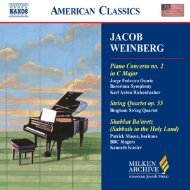Download Liner Notes PDF - Milken Archive of Jewish Music
Download Liner Notes PDF - Milken Archive of Jewish Music
Download Liner Notes PDF - Milken Archive of Jewish Music
Create successful ePaper yourself
Turn your PDF publications into a flip-book with our unique Google optimized e-Paper software.
a Jew by birth, he had not previously been involved<br />
with either religious or secular <strong>Jewish</strong> culture, but<br />
now he began exploring <strong>Jewish</strong> roots in his music—in<br />
the context <strong>of</strong> his own ever-evolving aesthetics. His<br />
first composition to address <strong>Jewish</strong> subject matter<br />
was Kristallnacht (1992), a Holocaust-related work<br />
inspired by the memory <strong>of</strong> the orchestrated pogrom<br />
throughout the Third Reich on November 9–10, 1938,<br />
which, following five years <strong>of</strong> increasing persecution,<br />
became the prelude to Germany’s eventual attempt<br />
to annihilate European Jewry altogether. A pastiche<br />
<strong>of</strong> songs and disparate sound elements that has been<br />
dubbed a “brutal sound portrait <strong>of</strong> the Holocaust”—<br />
ranging from references to traditional <strong>Jewish</strong> folk<br />
melos to chaotic, discordant, violent, screeching, and<br />
even ear-shattering noises—the recording contained a<br />
provocative warning on its jacket concerning its highfrequency<br />
extremes at the limits <strong>of</strong> human hearing<br />
and beyond: “Prolonged or repeated listening is not<br />
advisable, as it may result in temporary or permanent<br />
ear damage.” Kristallnacht marked a watershed in<br />
Zorn’s career, and following its release, he increasingly<br />
promoted himself and his self-invented persona as a<br />
“<strong>Jewish</strong> composer.”<br />
That newfound <strong>Jewish</strong> identity fitted comfortably into<br />
the downtown school’s partial shift during the 1990s<br />
from an essentially cosmopolitan sensibility to the<br />
concern with ethnic roots that had already fixed its<br />
hold on popular imagination elsewhere in American<br />
society. As the downtown musicians now began to<br />
exhibit curiosity about an array <strong>of</strong> world musics outside<br />
the Western cultural orbit, Zorn’s refashioned image as<br />
a “<strong>Jewish</strong> composer”—whatever that might mean—in<br />
some ways embodied that trend. For him, as with some<br />
fellow downtown musicians, that tendency toward<br />
ethnic awareness could provide an artistic anchor—a<br />
vehicle for focus and even a sense <strong>of</strong> mission.<br />
Also in the 1990s, Zorn, together with Marc Ribot,<br />
formulated a new initiative called Radical <strong>Jewish</strong><br />
Culture, whose stated purpose it is to extract, expose,<br />
and illuminate elements that he perceives to be<br />
<strong>Jewish</strong> components <strong>of</strong> American culture. Not all those<br />
subjective perceptions <strong>of</strong> what may constitute <strong>Jewish</strong><br />
components, however, are necessarily shared either<br />
by mainstream (including reasonably liberal) <strong>Jewish</strong><br />
cultural or social critics or by Judaically informed artists,<br />
many <strong>of</strong> whom would view some <strong>of</strong> those components<br />
as at most marginal if not superficial trappings. Others<br />
would go further to dismiss altogether the proposition<br />
that cartoon aesthetics, industrial noises, or pop- and<br />
rock-oriented fusions can have any legitimate role visà-vis<br />
<strong>Jewish</strong> artistic expression. For them, applying such<br />
features to cantorial chants or <strong>Jewish</strong> folk tunes, for<br />
example, risks diluting and even cheapening, rather<br />
than elucidating, <strong>Jewish</strong> content. To the most cynical<br />
detractors, some <strong>of</strong> what travels under that radical<br />
<strong>Jewish</strong> umbrella—and even what might motivate the<br />
undertaking in the first place—smacks <strong>of</strong> a questionable<br />
cross between contrived “hype” and a version <strong>of</strong> the<br />
post-1960s bandwagon <strong>of</strong> ethnic appropriation. How<br />
more recent, post-1990s phenomena such as vulgar<br />
sounds <strong>of</strong> human bodily functions or pornographic<br />
imagery fit into any conception, even radical, <strong>of</strong><br />
a “<strong>Jewish</strong> composer”—presumably connoting a<br />
composer whose music is intended for acceptance as<br />
“<strong>Jewish</strong>”—poses yet further questions.<br />
Still, actual <strong>Jewish</strong> themes have inspired some <strong>of</strong> Zorn’s<br />
most admirable works, some <strong>of</strong> which do indeed<br />
legitimately integrate aspects <strong>of</strong> authentic <strong>Jewish</strong> melos<br />
from a variety <strong>of</strong> sources. Improvisational chamber<br />
pieces, such as Bar Kokhba and Issachar, contain echoes<br />
<strong>of</strong> prewar eastern European <strong>Jewish</strong> life and explore<br />
comparisons between jazz and instrumental <strong>Jewish</strong><br />
folk music. His celebrated ensemble, Masada (one <strong>of</strong><br />
his several bands), is named after the plateau fortress<br />
15 8.559451
















